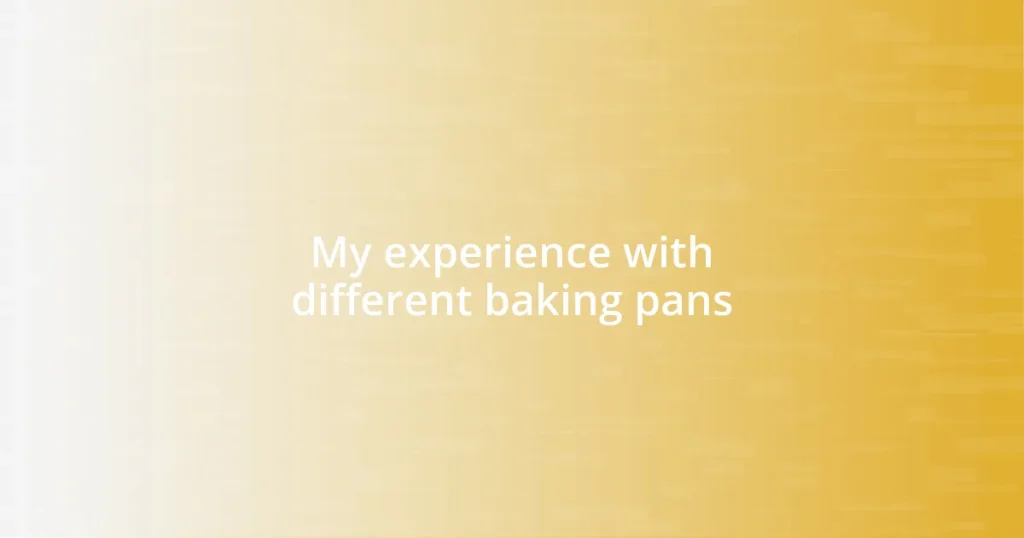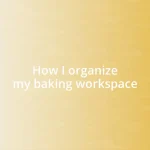Key takeaways:
- Different baking pans (metal, glass, silicone, ceramic) have unique characteristics that can greatly impact baking results.
- Choosing the right pan size and type is crucial to avoid baking mishaps, such as overflow or sticking.
- Maintaining baking pans, especially nonstick and glass, involves careful handling to ensure longevity and prevent damage.
- Personal experiences highlight the importance of learning from trial and error in baking, adapting techniques based on pan material.

My introduction to baking pans
When I first stepped into the world of baking, I was overwhelmed by the variety of pans available. I remember standing in my kitchen, gazing at my mismatched collection, feeling both excited and confused. Which pan was right for that elusive perfect cake I had been dreaming of?
My initial experience with a basic round cake pan was a revelation. The first time I used it, I poured in my batter with anticipation, heart pounding as it baked to golden perfection. That feeling of lifting a beautifully risen cake from the pan remains one of my most cherished baking memories, a blend of triumph and joy—I couldn’t help but smile when I served it to my family, their faces lighting up with delight.
As I dabbled more in baking, I learned about the different materials: glass, metal, and silicone. Each had its quirks, didn’t they? I often found myself wondering which would lead to the best results. Surprisingly, my silicone molds became my favorites, particularly for making muffins; the ease of pop-out was a game-changer!

Types of baking pans explained
When I think about the many types of baking pans, I can’t help but recall my countless trials and errors. Each material offered a unique experience. For instance, my first metal pan was an absolute workhorse. It heated evenly, and I loved how my brownies baked to a perfect crust. However, I quickly learned that it wasn’t so forgiving with delicate layer cakes; they tended to stick unless I used a good amount of grease.
Here’s a breakdown of some common types of baking pans and their characteristics:
- Metal Pans: Known for excellent heat conduction; great for even baking. Perfect for brownies and cookies but can lead to sticking if not properly greased.
- Glass Pans: Allow you to see the browning process, helping you avoid overbaking. I often prefer them for casseroles due to their non-stick surface when greased well.
- Silicone Molds: These are incredibly flexible and non-stick, making them my go-to for muffins and small cakes. I fondly remember how easily my mini cheesecakes popped out; it was like magic!
- Ceramic Bakeware: Offers beautiful presentation and retains heat for even cooking. I once used a vibrant ceramic dish for a lasagna, and it made for a stunning table display.
Each type of pan has its own charm, and I’ve come to appreciate how they can elevate the baking experience.

Choosing the right baking pan
Choosing the right baking pan can feel like a daunting choice, but with a bit of thought, it becomes clearer. I often think about how the wrong pan can affect the final result; I remember making a cake in a pan that was too small, only to find myself cleaning batter off the oven floor! It’s essential to choose a size that fits your recipe, or you might face a messy surprise.
When I bake, I also consider the recipe and its requirements. For instance, my go-to pan for lasagna is a deep rectangular one. The depth allows for layering, and it perfectly holds everything together, unlike my first attempt with a shallower pan that spilled over and created a kitchen disaster. Trust me, that experience taught me that the right shape can be just as crucial as the material!
Here’s a quick comparison that might help you navigate your choices in baking pans:
| Type | Best For |
|---|---|
| Metal | Brownies, Cookies |
| Glass | Casseroles, Layer Cakes |
| Silicone | Muffins, Small Cakes |
| Ceramic | Lasagna, Pies |

My experience with metal pans
Using metal pans has been quite the journey for me. I fondly remember the first time I pulled a batch of chocolate chip cookies from my shiny, new metal pan. The aroma that filled my kitchen was intoxicating, and the cookies had that perfect golden edge—crispy yet chewy. But oh boy, the moment I tried to bake a delicate sponge cake, I learned the hard way: that same pan just didn’t want to cooperate. It stuck like it was trying to win a battle, even after I thought I had greased it well.
As I kept baking, I started to appreciate the responsiveness of metal pans to oven heat. They preheat quickly and deliver searing temperatures, which can make all the difference when you’re racing against time. I remember one evening when I decided to make a quick batch of brownies for a last-minute gathering. I hoped to impress my friends, and the metal pan worked wonders; they baked in half the time I expected, and the result was a rich texture that I couldn’t wait to share. Have you ever been surprised by how a baking pan can elevate something so simple?
However, I’ve also had my share of mishaps, often leaving me frustrated. Once, I made a layered cake for a special occasion, and my novice self skipped the greasing step completely. As the layers began to crumble during the transfer to the serving platter, my heart sank. I realized then that metal pans, while great for even heating, require a bit more finesse to handle. It’s taught me to never underestimate the importance of preparation—because a little grease can be the difference between a masterpiece and a messy disaster!

My experience with glass pans
My experience with glass pans has truly been transformative in my baking journey. I vividly recall my first attempt at a fruit cobbler, using a glass baking dish. The moment I took it out of the oven, the sight of the bubbling fruit against the warm glass was just mesmerizing. Unlike metal pans, glass provided such even cooking that the top was perfectly golden without any burnt edges; it felt like I had unlocked a secret to baking perfection.
What I appreciate most about glass pans is how they allow me to keep an eye on the progress of my bakes. I remember when I decided to make lasagna for a dinner party—my trusty glass pan let me see just how the layers were melding together, which gave me confidence to adjust the bake time as needed. It’s like having a window into your creation! Have you ever felt that moment of joy when you can see your dish bubbling beautifully?
Of course, there have been a few surprises along the way. I once made a cheesecake in a glass pan and forgot about the temperature adjustment! Glass holds onto heat differently than metal, and I ended up with a slightly over-baked texture. It was a humbling moment that taught me to pay attention to my pan type. But let’s be honest—I still enjoyed every bite; a little misstep shouldn’t stop us from enjoying our baking adventures, right? That’s the beauty of baking, after all, you learn from every experience!

Comparing nonstick and silicone pans
I’ve had my fair share of experiences with both nonstick and silicone pans, and honestly, they each bring something unique to my kitchen. I remember the first time I tried a nonstick pan; the ease of sliding out a perfect sheet of cookies felt like magic. But when it came to baking sticky desserts, I often found myself regretting that choice, as some recipes still adhered to the surface, despite the nonstick promise. Have you ever thought you were totally safe with a nonstick surface, only to find it wasn’t as foolproof as expected?
On the flip side, silicone pans have given me a completely different baking experience. The flexibility of these pans amazed me the first time I popped out a delicate muffin. I mean, the way they just seemed to bounce right out without any resistance was exhilarating! Yet, I learned that silicone requires a bit of extra care with temperature—when I left a silicone cake pan in the oven for longer than intended, the edges charred while the inside remained stubbornly undercooked. That’s a moment I won’t forget; it taught me that each material has its quirks, and you really need to adapt your techniques accordingly.
In my adventures, I’ve found that using nonstick pans can lend a sleek, professional finish to baked goods, but they often need a layer of really good grease for sticky recipes. Meanwhile, silicone pans are fun and colorful, but I usually go through a mental checklist to prevent mishaps with cooking times. It’s all about finding the right balance, isn’t it? Which type resonates with you more—do you prefer the classic approach or the quirky flexibility of silicone?

Tips for maintaining baking pans
Maintaining your baking pans is essential for ensuring both their longevity and your baking success. I’ve discovered that hand washing nonstick pans is crucial. I learned the hard way when I tossed my favorite nonstick skillet in the dishwasher, only to find the coating scratching off. That experience taught me that gentle care protects the nonstick surface and keeps your baked goods sliding right out.
When it comes to glass pans, I’ve developed a habit of avoiding sudden temperature changes. I always let them cool slightly before plunging them into cold water. I remember one Thanksgiving, I made the mistake of doing otherwise, and the pan shattered! It was such a disappointing moment, but it served as a reminder that taking care of your pans means respecting their materials.
For silicone pans, I recommend storing them flat instead of stacking them. I once stacked my flexible molds, and when I tried to use them, I was met with a warped mess instead of perfectly shaped muffins. How frustrating is that? Learning the proper storage methods can save you from those little annoyances and keep your baking experience joyful and stress-free.















